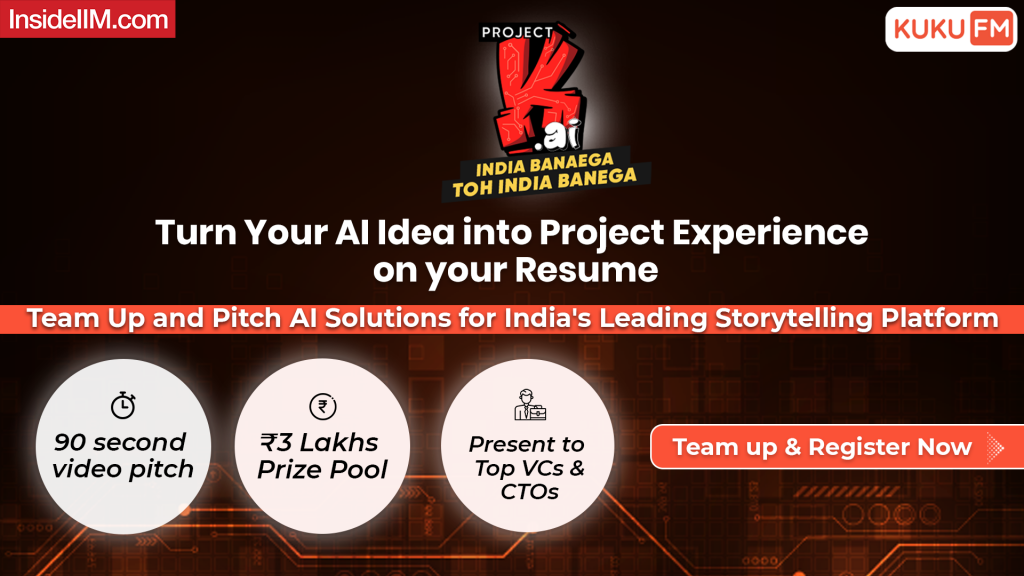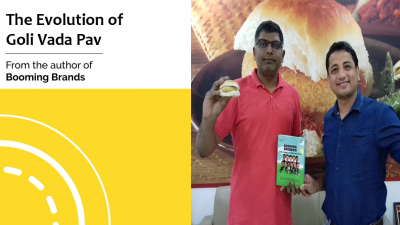Starting with a single store in 2004 outside Kalyan railway station, near Mumbai, Goli Vada Pav is now India's largest ethnic fast-food chain with over 300 stores in 100 cities across 20 states of India. The company sells more than 1 lakh vada pavs every day through its owned and franchised outlets.  Goli Vada Pav has been covered as a case study at the world's top business schools, such as Harvard Business School, IMD Switzerland, and ISB Hyderabad. The company has won numerous awards, including Coca Cola Golden Spoon Award, for being the most admired fast-food chain of Indian origin. Moreover, Travel + Leisure, an international travel magazine owned and published by Time Inc., has featured Goli Vada Pav amongst the top 20 QSR brands in the world. In 2013, one of India's leading research agencies rated Goli Vada Pav as the sixth-largest fast-food company in India. Interestingly, the first five slots were occupied by international brands - Domino's Pizza, McDonald's, Pizza Hut, KFC, and Subway.
To know about the journey of Goli Vada Pav, we interviewed Harsh Pamnani, who is an MBA from XLRI Jamshedpur and author of the bestselling book Booming Brands (published by CNBC). In his book, he has covered inspiring journeys of many new age ‘Made in India’ brands, including Goli Vada Pav.
Goli Vada Pav has been covered as a case study at the world's top business schools, such as Harvard Business School, IMD Switzerland, and ISB Hyderabad. The company has won numerous awards, including Coca Cola Golden Spoon Award, for being the most admired fast-food chain of Indian origin. Moreover, Travel + Leisure, an international travel magazine owned and published by Time Inc., has featured Goli Vada Pav amongst the top 20 QSR brands in the world. In 2013, one of India's leading research agencies rated Goli Vada Pav as the sixth-largest fast-food company in India. Interestingly, the first five slots were occupied by international brands - Domino's Pizza, McDonald's, Pizza Hut, KFC, and Subway.
To know about the journey of Goli Vada Pav, we interviewed Harsh Pamnani, who is an MBA from XLRI Jamshedpur and author of the bestselling book Booming Brands (published by CNBC). In his book, he has covered inspiring journeys of many new age ‘Made in India’ brands, including Goli Vada Pav. 
Debayan: Why did you cover Goli Vada Pav in your book?
Harsh: Burger, pizza, and coffee are commoditized products, but entrepreneurs like Ray Kroc, Tom Monaghan, and Howard Schultz created unique business opportunities around these products and built world-class brands – McDonald's, Domino's Pizza and Starbucks respectively. What Ray Kroc did with the burger, Tom Monaghan did with pizza, and Howard Schultz did with coffee, Venkatesh (Venky) Iyer is doing with vada pav. He has turned a commoditized product into a popular brand and has taken vada pav from the streets of Mumbai to pan India. The way people admire international fast food brands and learn from their case studies, they should also know the journey of this Indian brand. Hence, I covered Goli Vada Pav in Booming Brands.
Debayan: Tell me how Goli Vada Pav got started?
Harsh: Venky Iyer was born in a middle-class Tamil-Brahmin family. Like every middle-class family, his parents wanted him to study well and become an engineer or doctor or chartered accountant or do his MBA and work in some big multinational company. Because of being an average student, he used to listen at home – "If you don't study well, you will end up selling vada pavs." No one, including Venky, ever imagined that one day, he would become the world's most popular vada pav-wala.
After completing his education, Venky spent more than 15 years in the financial services sector. In those days, one of his friends, who used to work as a senior executive in a global food company, indicated his frustration by saying that “No matter what you do, Indians will eat Indian food only!” In this statement of his friend, Venky sensed an opportunity. One afternoon, Venky arrived near Mumbai’s Chhatrapati Shivaji Terminus for a meeting. He was hungry, and he bought vada pav from a roadside vendor. After walking a few steps, he noticed a 30 feet wide McDonald's banner hanging from a building, announcing the opening of the restaurant in that location.
He looked at the burger on the banner and the vada pav in his hand and found that both the products were similar. He instantly visualized these two fast food products as look-alike twins. This was the time, when an idea crossed his mind – if McDonald's can become one of the world's largest fast-food company by selling burgers, then why couldn't a fast-food chain be created around a similar product – vada pav.
Debayan: Goli Vada Pav is one of the most popular brands in India. How did Venky come up with this name?
Harsh: Goli is one of the commonly used words in Mumbai lingo. When Venky shared his plan of leaving finance and starting a vada pav business with his family, friends, and colleagues, no one believed him. After listening to his plan, people used to say,
“Kya goli de raha hain?” (You must be bluffing!). He listened to this statement from almost everyone he met and shared his idea.
Further, in Mumbai, the round raw potato patty is called ‘goli’, which after dipping into gram flour mix and frying, becomes ‘vada’. Therefore, the team decided to call the brand 'Goli Vada Pav'.
Debayan: Can you tell me how Goli Vada Pav has been able to provide consistent taste pan India?
Harsh: People prefer to buy a branded product or service because they get consistent quality and experience. For providing consistent brand experience, all the back-end operations have to run very well. Creating consistent taste, was definitely not an easy journey.
To provided consistent taste, Venky established a centralized kitchen. By the end of 2005, Goli Vada Pav became a 20-store chain (3 owned stores and the remaining, franchisee stores) in Kalyan and nearby areas. Venky was happy to see that his model was working, but then he found a few loopholes in operations. The golis that were getting created in the centralized kitchen had a shelf life of only 10 -12 hours, so the golis that used to get supplied to stores in the morning were stale by late evening. On a daily basis, nearly 3,000 golis were getting wasted. Then he got to know about pilferage. A few franchisees used to pull out a small quantity of material from the original golis and create extra golis to increase their profits. This led to smaller sizes of vadas at a few of the stores. Another problem arrived when the chef went on vacation. The new chef made some changes in the masala mix, and the taste of vada pav changed.
Venky realized that he couldn’t establish Goli Vada Pav as a brand without uniformity in taste and consistent standards. Another issue was that the prices of ingredients were not static, and whenever prices of ingredients such as potato and onion used to go up, his margins used to go down. Though the product demand was continuously increasing, franchisee enquires were continuously coming, and sales numbers were rising, the business was not making profits due to operational challenges. The business that expanded quickly till 2005 end started looking unviable in 2006.
For getting a solution to his problems around standardization, pilferage, and taste, he met many people in the food industry and tried many experiments, but nothing worked. All his experiments failed, and he lost a lot of money. Eventually, he found the company Vista Processed Foods, the sole supplier of burger patties to McDonald’s in India. Venky partnered with this company, and his raw vada pav golis started getting manufactured in a world-class automated plant. This partnership became the foundation of standardized back-end operations and growth of Goli Vada Pav. Though the partnership with Vista, Goli Vada Pav solved the problems of wastage, pilferage, and non-standardization.
Debayan: You told me how inspiration and backend model from McDonald’s helped Goli Vada Pav. Can you also tell me how Goli Vada Pav has been different from McDonald’s?
Harsh: Firstly, the burger has patty, mayonnaise, lettuce, etc. between the bun. However, vada pav has vada, chutney, and chili between the pav. One is non-spicy, the other is spicy.
Secondly, the vadas manufactured in Vista’s plant are frozen, and frying these frozen vadas requires a different kind of fryer. The fryers used by McDonald's were extremely expensive, and buying these fryers for multiple stores would have made Goli's business model unviable. Venky decided to create his own chip-based automatic fryer at an affordable cost. Eventually, 'Goli fryer' was invented at a much lower cost as compared to the fryers used by McDonald's.
Thirdly, the space required for expansion is different. For instance, McDonald's stores need approximately 3,000 square feet or more real estate, air conditioning, seating space, etc. Due to location constraints and finance requirements, McDonald's stores cannot be opened everywhere, unlike vada pav stores that require just around 300 sq. ft. and no AC or seating space.
There are a few other interesting points that I have covered in the book.
Debayan: Can you share one marketing strategy of Goli Vada Pav?
Harsh: Goli Vada Pav has many interesting marketing strategies. Let me share with you one of them – brand placement in movies through barter. One day, Venky met a film producer of a Marathi movie and asked him about his plans to market the movie. The producer gave all traditional answers that required a lot of money. Venky told him about Goli's presence in Maharashtra and informed him that daily thousands of people visit Goli's stores, and the movie's posters could be put up in these stores. The producer agreed and in exchange, promised to show Goli Vada Pav in the movie. A Goli branded bus-stop was created and showed in two shots in the movie, and movie posters got visibility across all Goli stores. Later on, similar barter deals were done for many other Marathi movies.
Debayan: Can you share one piece of advice that Venky Iyer shared with you for Booming Brands’ readers?
Harsh: Venky has given multiple advice. One of them is, imagination and exploration are very important traits of entrepreneurship. Through imagination, an entrepreneur can think beyond defined limits and boundaries, and through exploration, he can find new solutions that were not thought of by others in the past.
Harsh Pamnani with Venky Iyer, CEO of Goli Vada Pav
***
You May Also Be Interested In Reading -




